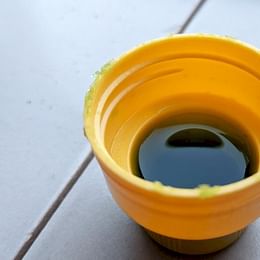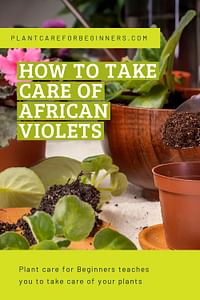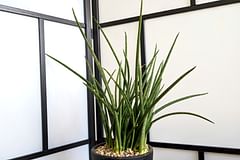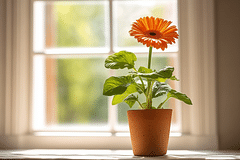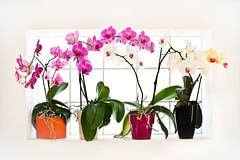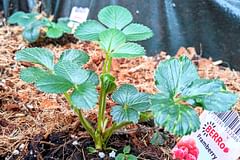How to take care of African Violets
African Violets are the perfect plant for you and your house if you love colorful flowers and have pets. In this plant care guide, we're going to look at how you can take care of this beautiful flowering houseplant and help it thrive in your house!
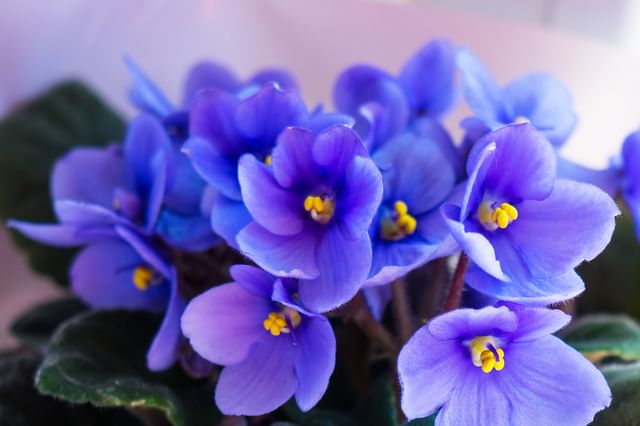
African Violets are the perfect plant for you and your house if you love colorful flowers and have pets. These plants stay small, so they're great for those space-limited areas in your house. With the right care, you can help your African Violets flower all year round!
Just a heads-up, the African Violets are considered to be difficult to care for plants, but the tips in this guide will make it much easier to help your plant thrive.
In this plant care guide, we're going to look at how you can best take care of your African Violet. These are the topics we're going to look at in this plant care guide:
Let's dive right in to explore everything there is to know about your African Violet to help it thrive and grow its beautiful flowers.
Watering your African Violet
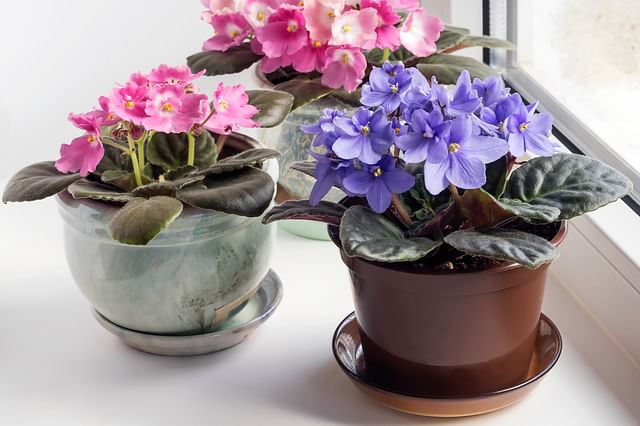
Watering your houseplants is one of the most important things to keep your plant happy, so let's look at how to water the African Violet properly. African violets are plants that, as its name suggests, are native to the African continent. They grow in the tropical rainforests of Kenya and Tanzania. This gives us a clue about the watering needs of the plant.
The African Violet likes its soil to stay lightly moist at all times, just like it would in its natural habitat. However, the African Violet is also quite sensitive to overwatering, so don't let the plant sit in wet soil. To prevent your plant from sitting in water, make sure to use a pot with drainage holes. Further on in this guide, we'll look at the type of soil that makes it easier to prevent overwatering your plant.
Another important part of watering your African Violets is that they shouldn't get any water on their leaves when you water them. These water drops will leave brown marks on the plant's leaves. The easiest way to water your plant is through bottom-watering. This lets the plant soak up moisture through the drainage holes and doesn't get any water on the leaves.
Make sure the water you use to water your African Violet is room temperature, as its roots are sensitive to cold temperatures.
Sunlight for your African Violet
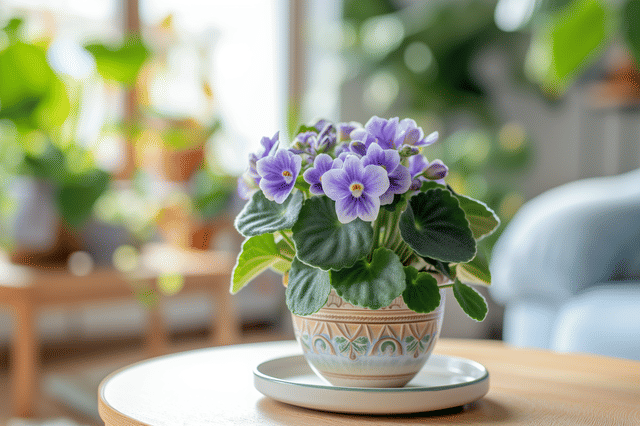
The second most important thing to keep your African Violet happy is the right sunlight exposure. The African Violet can grow flowers all year round, but for it to do that, you'll need to provide it with plenty of indirect sunlight. The African Violet doesn't do well if you expose it to direct sunlight, but it loves bright indirect sunlight. The direct sunlight will leave burn marks on the sensitive leaves of your African Violet.
You know you've got the right sunlight exposure if your plant doesn't get any direct sunlight, but your hand can still cast shadows. The perfect place for your African Violet is a spot in the middle of a room with a south or west-facing window.
Sunlight exposure for your African Violet in the winter
In the winter, when the sun isn't as strong, you'll need to move your plant a little closer to a window. This type of sunlight is too harsh during the spring and summer but is fine during the fall and winter. When you move your plant closer to the window, you give it a little extra sunlight exposure during this darker time of the year.
Temperature and humidity for your African Violet
African Violets thrive in specific temperature and humidity ranges that have a big influence on the growth and health of these unique plants.
Generally, African violets like a warm and comfortable environment with a temperature range between 15 to 27 degrees Celsius (60-80 F). This temperature range creates a comfortable growing environment for these plants.
For humidity, African Violets need a relatively high-humidity environment to maintain their health. The ideal humidity levels should range between 40% to 60%. You can raise the relative humidity of your plants by using a humidifier or by placing a tray of water near the plant.
Dry air can lead to wilting and damage to the leaves and flowers. Your African Violet can't heal these leaves and flowers if they've gotten too much damage and can only look good again when you trim the plant and let it grow new leaves. This takes a little while depending on the season.
It's also important to avoid placing African Violets in areas with extreme temperature changes, such as near air conditioner vents and drafty areas. These changes in temperature and humidity can cause stress to the plants, leading to them becoming unhealthy and vulnerable to pests and diseases.
The perfect soil for your African Violet
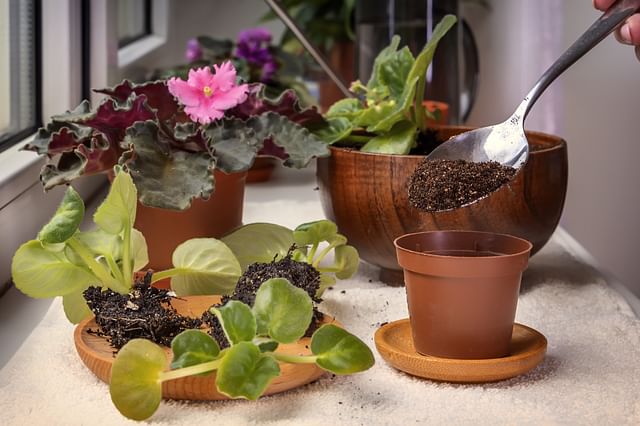
Let's get to the best soil for your African Violet! Earlier, in the section about watering, I mentioned that the African Violet likes the soil to always be lightly moist. However, the plant is also quite sensitive to overwatering, so the soil we use should do two things: Retain moisture for multiple days and drain any excess water to the bottom of the pot quickly.
The best mixture of soil for this type of plant would be 1/4 potting soil, 1/4 coconut coir, 1/4 perlite, and 1/4 coarse sand. This provides the plant with nutrient-rich soil, plenty of water-retaining properties, and excellent drainage through perlite and sand. However, you can also buy pre-mixed bags at your local plant shop or order them online, which will save you a bit of time.
Fertilizing your African Violet
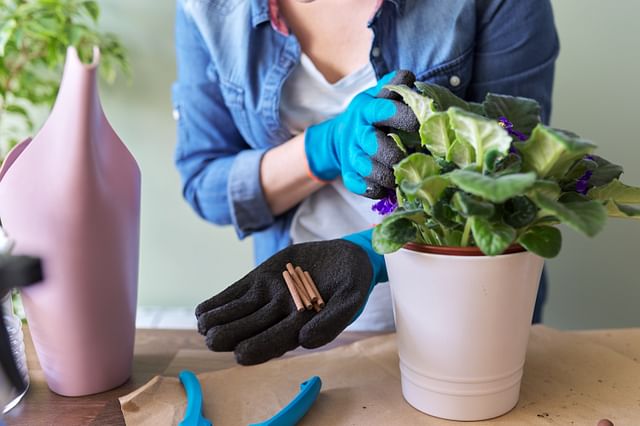
You already know that the African Violet is a flowering plant. It grows flowers in many different colors. Flowering plants use a lot of energy to grow these beautiful flowers.
During the spring and summer, when this plant grows the most, you'll need to fertilize it once every 14 days. This helps the leaves to stay healthy, while also giving the plant plenty of energy to grow its flowers.
If you've recently repotted your African Violet, or you recently bought one from the store, you won't have to fertilize your plant yet. Most pre-mixed bags of soil contain a slow-release fertilizer for the first 100 days of use. The fresh soil is full of nutrients and when you over-fertilize, this can kill the plant. You know when it's time to fertilize your plant when the growth is slowing down and the leaves seem pale.
Fertilizing your African Violet in the winter
In the winter, when your African Violet is getting less sunlight and it's not growing as quickly, you shouldn't fertilize your plant. Your plant won't use the fertilizer during these darker days and it's very easy to over-fertilize your plant.
Any fertilizer you apply to your plant during the winter will most likely stay behind in the pot and can cause rootburn. Rootburn happens when there are too many nutrients in the soil, which can damage the plant's roots. This nutrient buildup can cause the roots to dehydrate. Most fertilizers contain salts, and too much of it will dry out the roots, preventing them from absorbing more moisture from the soil.
How and when to repot your African Violet
African Violets are plants that don't grow very large, so you wouldn't expect to repot them very often. And you'd be right! The African Violet likes to grow in a pot that's slightly too small for its roots because this helps it to grow flowers.
It's a good idea to repot this plant once every 2 years because this allows you to refresh the soil and give it a slightly larger growing environment. When you repot your plant, only repot in a slightly larger pot, because a container that's too large won't promote flower growth.
Repotting an African Violet is easy, so let's look at a few easy-to-follow steps to successfully repot your plant:
- Carefully remove the African Violet from its current pot, taking care not to damage the roots. If the plant is stuck, gently loosen the roots and soil by squeezing the pot (if possible) or using a blunt tool like chopsticks to separate the roots from the pot.
- Trim any dead or rotten roots, as well as any dead leaves or flowers. These may attract fungus and rot your plant.
- Add a thin base layer of soil to the new pot. Around 2cm or 1 inch is enough.
- Set the plant in the new container on top of the base layer and add fresh potting soil around the sides. Gently press the soil down around the plant to remove air pockets.
- Water your African Violet thoroughly, being careful not to get water on the leaves. Let the excess water drain out of the container.
- Place your newly repotted African Violet in a spot with bright, indirect light. Avoid direct sunlight, as this can burn the leaves.
Now that you've repotted your plant, be sure to check the soil moisture regularly. The bigger pot, with more soil, means that more moisture stays behind in the pot. In the first few weeks, this might mean it takes longer for the soil to dry out. By regularly checking the soil moisture, you make sure you're not watering your plant when it's not quite ready for it yet.
Pruning and deadheading your African Violet
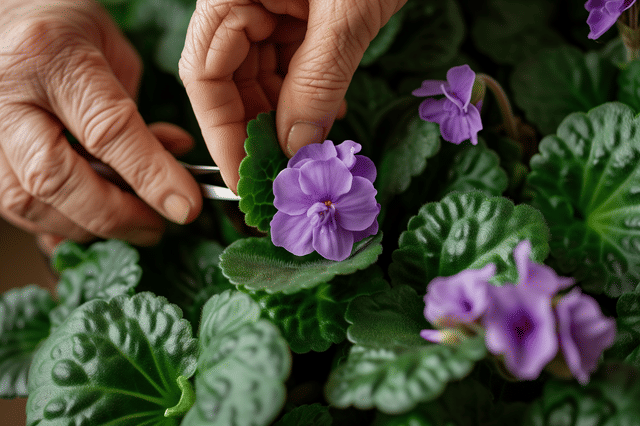
Regular pruning and deadheading can promote healthy growth and flowering in African violets. Pruning is when you selectively remove stems or leaves from a plant, while deadheading is simply removing faded blossoms. In this section, we'll look at steps to make sure that your African Violets stay healthy and look great for longer. Pruning and deadheading may sound scary, but it's easy once you have an idea of where to start.
How to prune your African Violets
Start by checking your plant for any damaged or diseased leaves or stems. These are the first to go as they can spread diseases and be a magnet for pests. You don't have to wait for a specific time of year to prune these stems and leaves, you should do this as soon as you notice any issues.
After all dead stems and leaves are gone, you can choose to prune leggy growth. Choose leggy stems to prune back to encourage new growth. Use clean, sharp scissors to make a clean cut as close to the base of the stem as you can.
Keep in mind that African Violets prefer to be moderately pruned, meaning you should trim no more than ⅓ of the plant at a time to avoid shocking your plant's system.
How to remove spent flowers
As soon as a blossom begins to fade, gently pinch it off with your fingertips just above the base of the stem. Be sure to remove the entire flower and its stem to prevent the plant from wasting energy trying to revive it. It's important to keep up with regular deadheading as it both promotes healthy growth and improves the overall appearance of your plant.
Propagation methods for your African Violets
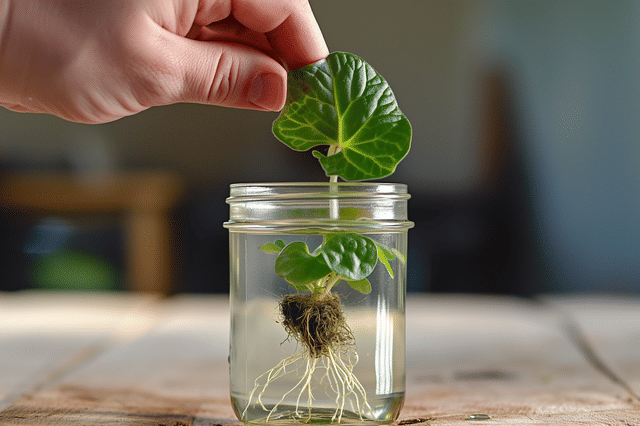
Propagating African Violets is an exciting and fulfilling experience. There are different ways to multiply this houseplant. Let's learn about each one.
Leaf cuttings
One of the most common methods of propagating African Violets is through leaf cuttings. To do this, select a healthy leaf and cut it off from the parent plant at the base of the stem. Be careful not to damage the leaf or its stem, as it will be needed later. Afterward, put the leaf-cutting in a small jar with water to help the stem grow roots. Make sure to refresh the water once per week to avoid fungal problems. Within a few weeks, you should see roots and new growth appear from the base of the stem.
Crown division
Another way to propagate African Violets is through crown division. This method works best for mature plants that have a developed crown: a set of leaves at the center of the plant.
To do this, gently remove the African violet from its pot and carefully pull apart the crown into two or more sections. Each section should have a healthy root system, some leaves, and a portion of the crown. You can plant each section in its pot filled with a well-draining soil mix, water it well, and place it in a bright but indirect light location.
You may be wondering how to tell when a crown has developed for your African violet. Lucky for you, there are a few signs that you can look for! A crown typically forms at the base of the African Violet, just above the soil. You should notice a rosette of leaves forming in this area, which will eventually grow into a mature crown. These leaves will look slightly different than the rest of the leaves on the plant, and they may have a lighter or more vibrant color.
You may also notice that your African violet is growing more quickly and producing more leaves than usual. This is a good indication that a crown is forming and the plant is healthy.
Seasonal care for your African Violet
Your plants, including your African Violet, need different care throughout the year. Not only winter sunlight exposure and fertilizing are different for each season, but there are other seasonal care considerations that you should be aware of.
Watering
In terms of watering frequency, African Violets typically do best in stable moisture levels. To avoid overwatering, wait until the soil surface feels dry to the touch before watering again. In the summer, you might need to adjust your watering frequency because plants tend to lose water faster due to high temperatures and wind.
And during the winter months, it's important to note that African Violets may require less water than they do in the summer. So, be sure to adjust your watering schedule accordingly to prevent excess moisture buildup that can promote root rot.
Temperature
African Violets prefer moderate temperatures (15 to 27 Celsius or 60 to 80 F), so try to avoid placing them in areas with sudden temperature changes or direct sunlight during the summer months. If you live in an area with temperatures higher than 27 degrees Celsius (80 F), you might have to shade your plant or increase watering.
During the winter, the moderate temperatures inside our homes should be sufficient, but it's important to remember to keep African Violets away from drafty windows, doors, or heating units.
Humidity
Besides temperature and humidity levels have a big impact on your plant's health. During summer, if you live in a dry area, you might have to increase the humidity by misting the plants or using a humidifier. In the winter, if you live in a cold area, you might also need to increase the humidity as central heating systems will dry out the air in your house.
Pest control for your African Violet
When it comes to African Violets, it's important to keep an eye out for common pests that can damage or even kill your plant. One of the most common pests you might encounter are aphids, small insects that can cause stunted growth and yellowing of leaves. Another pest to watch out for is mealybugs, which look like small white fluffs and can cause leaf curling and yellowing. Spider mites are another common issue for African Violets, causing tiny yellow spots on the leaves and webbing around the plant.
To identify these pests, you'll want to keep an eye out for any signs of damage or discoloration on your plant. You can also inspect the leaves and stems for any visible pests or egg sacs. If you suspect an infestation, it's important to take quick action to prevent further damage.
When you notice any pests on your plant, isolate the plant from your other plants to prevent the pests from spreading to other plants. Then you can start to help your plant.
There are a few different methods for dealing with pests on your African Violets. One option is to use an insecticidal soap or oil, which can be sprayed directly on the plant to kill pests. You can also try using neem oil, a natural pest repellent that is safe for use on plants.
Preventing pests from infesting your African Violets in the first place is the best approach. Practice good plant hygiene by keeping your plant clean and dust-free, and avoiding overwatering. You can also keep your plant isolated from other plants to prevent the spread of pests.
Troubleshooting common problems

In this guide, we've covered the basics of African Violet care, but you might still run into some issues. Don't worry though, I've got a few helpful troubleshooting tips! We're going to look into some common problems that you might encounter when caring for your African Violets, and some effective solutions to help you overcome them.
Yellowing leaves
Yellowing leaves are a common issue and can be caused by a few different things. One possible cause is overwatering. Also, make sure your plant is getting enough sunlight but not direct light, which can also cause yellowing leaf damage. If you've checked both of these things and are still having issues, you may need to consider repotting or adjusting the soil pH.
Stunted growth
If your African Violet is not growing well, it may be due to lighting or nutrition issues. Make sure your plant is getting enough light, but not too much, and consider using a fertilizer specially made for African Violets to boost growth. Remember your African Violet doesn't like direct sunlight and you should only fertilize it every 14 days, but not at all in the fall or winter.
Root rot
Root rot is a common problem that African Violets face and it can cause significant damage. This issue usually happens due to overwatering or poor drainage. To prevent root rot, it's important to ensure that the plant is in a pot with proper drainage holes and well-draining soil. Additionally, only water the plant when the soil is slightly dry to avoid overwatering.
Toxicity for your pets or children

In the introduction, I've already mentioned the African Violet is pet-safe, so you can keep it around your cats and dogs without worrying about their well-being. Even if your pets decide it's a great idea to eat the leaves or stems of your African Violet, they won't be harmed.
The good news is that African violets are also not considered toxic or harmful to children. They are safe to be around and touch, even for curious little ones who may explore the world with their mouths.
Conclusion
In this plant care guide, we've looked at how you can take care of your African Violet. We've looked at how to water your African Violet, the best sunlight exposure, the best soil for your African Violet, how to fertilize your plant best, and whether your African Violet is safe for your pets and kids. The African violet is one of the most popular flowering houseplants in the world for a reason! It can be a tricky and fussy plant at times, but if you follow the advice in this guide, you'll surely help your plant to thrive!
Thank you for reading this post! I hope it helps you to keep your plants healthy and beautiful! If you're looking for more guides on specific plants, you can always request a plant guide to get a guide for the plant you have trouble with.
Test your plant care knowledge
Quiz completed!
Want to learn more? Sign up for my newsletter to receive free tips in your inbox!
Sign up now!

